The ‘Granite State’ of New Hampshire is home to the White Mountain region, the Eastern New England Uplands, and the Appalachian Highlands. These 3 primary regions form a combination of scenic environments where many bird come to visit and some to settle! Today we are going to talk about some of those birds. We’ll discuss the popular backyard birds of New Hampshire and give you the feeder-scoop on what they enjoy snacking on, where they like to hide, and identification giveaways so that you can spot and identify these birds like the pro-birder that you are. Let’s talk about Avian species in New Hanmpshire!
3 Categories – 300 Birds
With approximately 300 species making this state their temporary or permanent home we find ourselves a little limited in space. To keep things easily digestible, we are going to take a sampling of birds during different seasonal times which we will divide like this:
- Year-round Resident birds
- Birds of Spring, Summer, and Early Fall
- Fall and Winter Birds
One you have the ‘when’, you just need to know where the birds may be found and how to tempt them and we’ll give you our best tips on that subject. Let’s get started with the year-round resident birds.
New Hampshire’s Year-round Resident birds
These birds hang their little hats in New Hampshire and may be found at any time of the year – provided that you know where to look! Let’s explore a few of these birds in greater detail and see if you can spot them:
- Tufted Titmouse
- Mourning Dove
- Downy Woodpecker
- American Goldfinch
- Black-capped Chickadee
Tufted Titmouse – Baeolophus bicolor
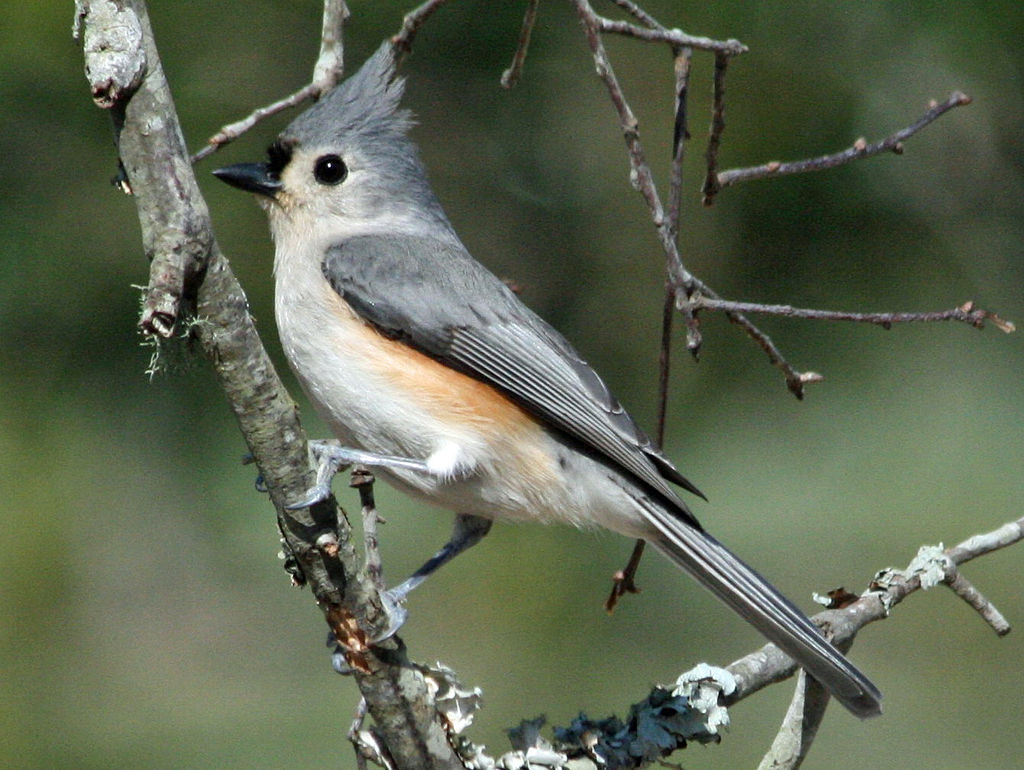
Coloration and Markings: The Tufted Titmouse have a blue-gray back, with medium-length blue and gray wings and a long, blue and gray tail. The underbelly and breast of this bird are white, with a faint splash of peach wash visible at the flanks if you are looking closely. Facially, the first thing that you notice is the mostly-white face and the small, but beautiful blue crest. Some blue coloration creeps down from the back of the crest to outline the back of the eyes and almost goes down the back of the neck. A black spot above the bird’s small, triangular bill will also be present.
Size: These birds measure in at 5.5 – 6.3 inches in length and have wingspans of 7.9 to 10.2 inches.
Habitat: These birds prefer Evergreen and deciduous woods, typically at lower altitudes. They are tiny but quite bold, ranging out often to visit gardens, orchards, parks, and backyard feeders which have been stocked in anticipation of their arrival.
Diet: Peanuts, suet, and Nyjer thistle are 3 favorites of the Tufted Titmouse which are easy to provide and might just make you a new, cute little friend.
Mourning Dove – Zenaida macroura
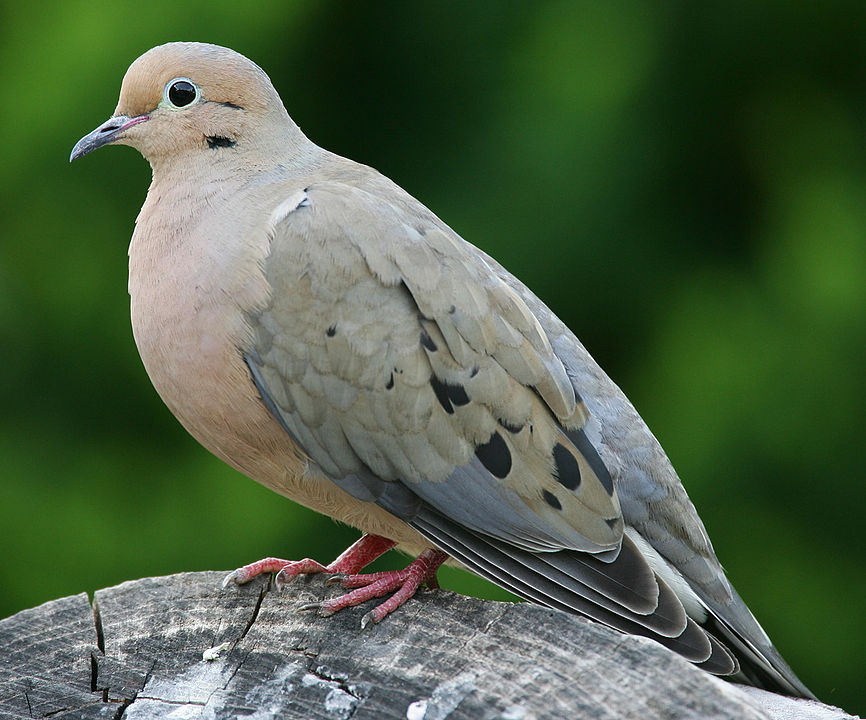
Coloration and Markings: Mourning Doves have gray backs with large, gray wings that bear a heavy concentration of buffy tan color as well as large, distinctive black spots. They have long, pointy tails, and the underbelly and breast of this bird will be a mix of heavy tan to salmon coloration with bits of white peeking out. Facially, these birds will be pinkish-tan and a distinct white eyering will be present. These birds have thin, medium-length black bills.
Size: These birds measure in at 9.1 – 13.4 inches in length and have wingspans of approximately 17.7 in width.
Habitat: These birds love open areas, such as overgrown fields or even bare spots of earth. They have been foraging around people long enough that you are unlikely to find them in the woods but with a little patience you will find that they are all over the city.
Diet: Black Oil Sunflower seeds are a favorite of this bird but they also enjoy cracked corn and White Proso millet.
Downy Woodpecker – Picoides pubescens
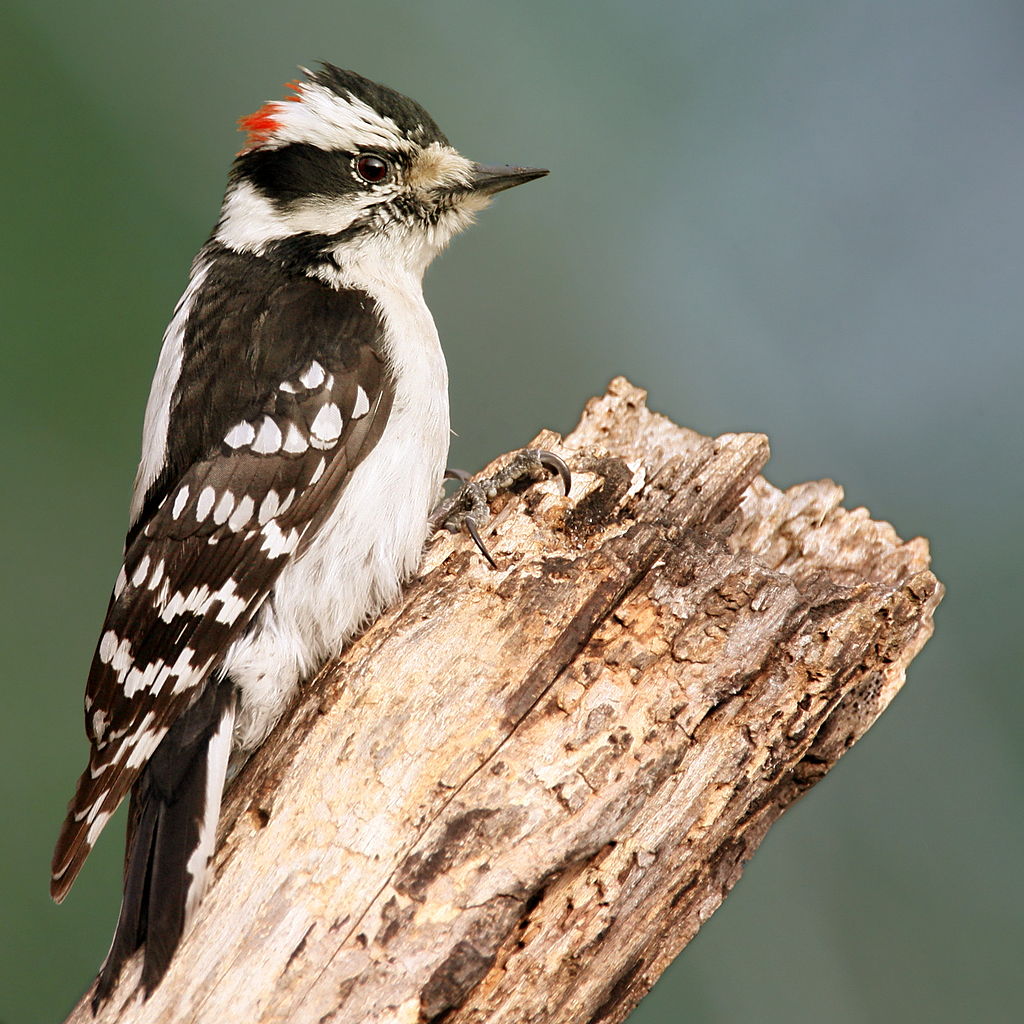
Coloration and Markings: Downy Woodpeckers have a broad, white stripe on their backs along with long, black wings which bear a spaced pattern of stripes that is made from squarish spots, giving the wings a checkerboard look. They have short, stout, and notched black tails with white undersides and the underbelly and breast of this bird will be paper-white as well. Facially, these birds have white faces with a black mustache line, a black ‘bandit mask’ which goes to the back of the head, and a thin, black crown, which will show a red spot towards the back of the head if you are looking at a male. These birds have thin, medium length bills.
Size: These birds measure in at 5.5 – 6.7 inches in length and have wingspans of 9.8 to 11.8 inches wide.
Habitat: Downies prefer open areas with deciduous trees present. Ground cover makes them feel more comfortable, so look for them around shrubs, brambles, and briars and don’t limit your search to the woods. These birds like to visit gardens, orchards, and backyards as well!
Diet: A mix of dried fruits and peanuts is an easy way to attract a hungry Downy to your backyard feeder. They are also very, very fond of suet.
American Goldfinch – Spinus tristis

Coloration and Markings: American Goldfinches have bright yellow backs with long, black wings. These wings display 2 white wingbars on each wing and a series of vertical white markings towards the center of the wings. They have short, notched tails which will also have white markings present and this bird has a white rump. The breast and underbelly, however, will be bright yellow, as is the bird’s face. Aside from the yellow in the face, this bird has a black cap from the bill to the middle of the head and it looks almost like a little toupee. This bird has a medium-length, conical orange bill. Female Goldfinches will have olive coloration in the wings instead of the black and tend to have more muted yellows and in the winter, both genders change into a rather dull brown plumage that doesn’t quite hide the white wingbars.
Size: These bright little birds measure in at 4.3 – 5.1 inches in length and have wingspans of 7.5 to 8.7 inches wide.
Habitat: These birds love open, overgrown fields, especially those which are prone to flooding. You can also find them in parks, gardens, and backyards.
Diet: Hulled Sunflower seeds of any kind and Nyjer thistle, mixed together, make a tempting combination that can lure an American Goldfinch to your feeder.
Black-capped Chickadee – Poecile atricapillus
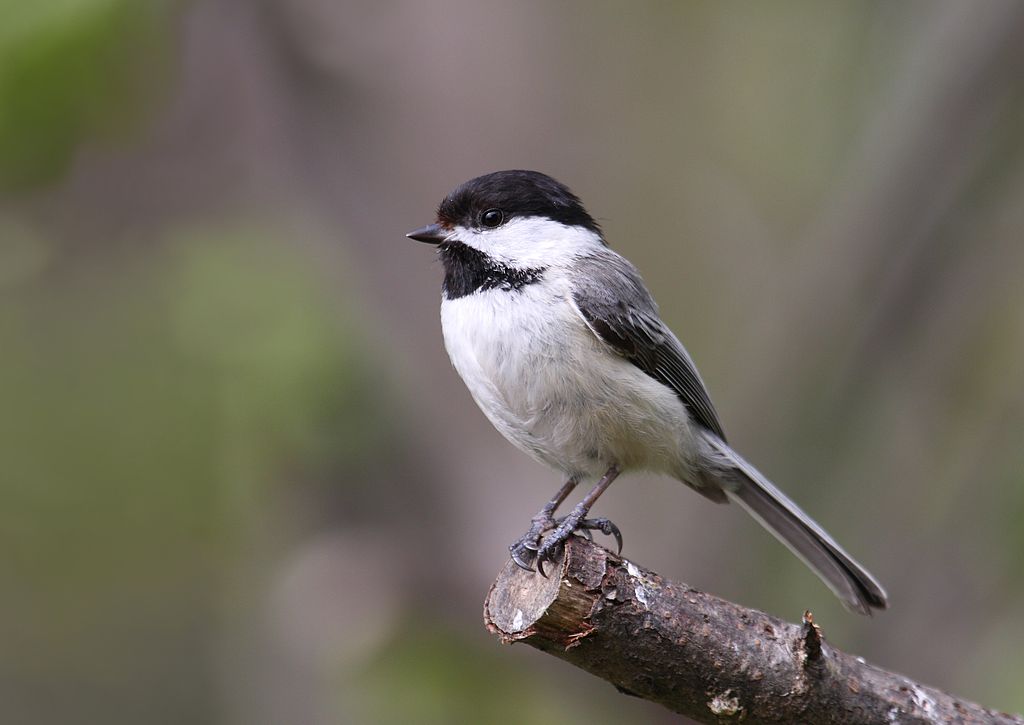
Coloration and Markings: Black-capped Chickadees have short wings with long, gray tails. The wings will display some white edging accenting the plumage and the tails often have white outer feathers. The underbelly and breast of this bird are a crisp white but if you look closer there are faint traces of tan coloration at the sides. Facially, this bird has a white face with a black bib and a large, black cap that terminates at about mid-eye level. This bird has a tiny, conical black bill.
Size: These birds measure in at 4.7 – 5.9 inches in length and have wingspans of 6.3 to 8.3 inches wide.
Habitat: If you have got shrub cover and trees, then you’ve got the perfect environment for chickadees. Look for them anywhere that there are bushes, brushes, brambles, thickets, or thorns close to a tree or two. Marshes are also favorite haunts of this bird, which likes to perch on cattails while looking for snacks, and small fields, parks, and backyards are also frequent places to find this bold little species of Chickadee.
Diet: Hulled Black Oil Sunflower seeds are a Chickadees favorite and easy to provide. Put some out and watch these little guys go to town!
New Hampshire’s Birds of Spring, Summer, and Early Fall
It all starts out with deer footprints increasing in volume along with acorn husks all over the place. Before you know it the Red Maples are turning crimson and birds start arriving in droves. During these warmer months you can see a number of different birds. See if you can spot one of these little angels this year:
- Cedar Waxwing
- Gray Catbird
- Red-eyed Vireo
- American Robin
- Scarlet Tanager
Cedar Waxwing – Bombycilla cedrorum
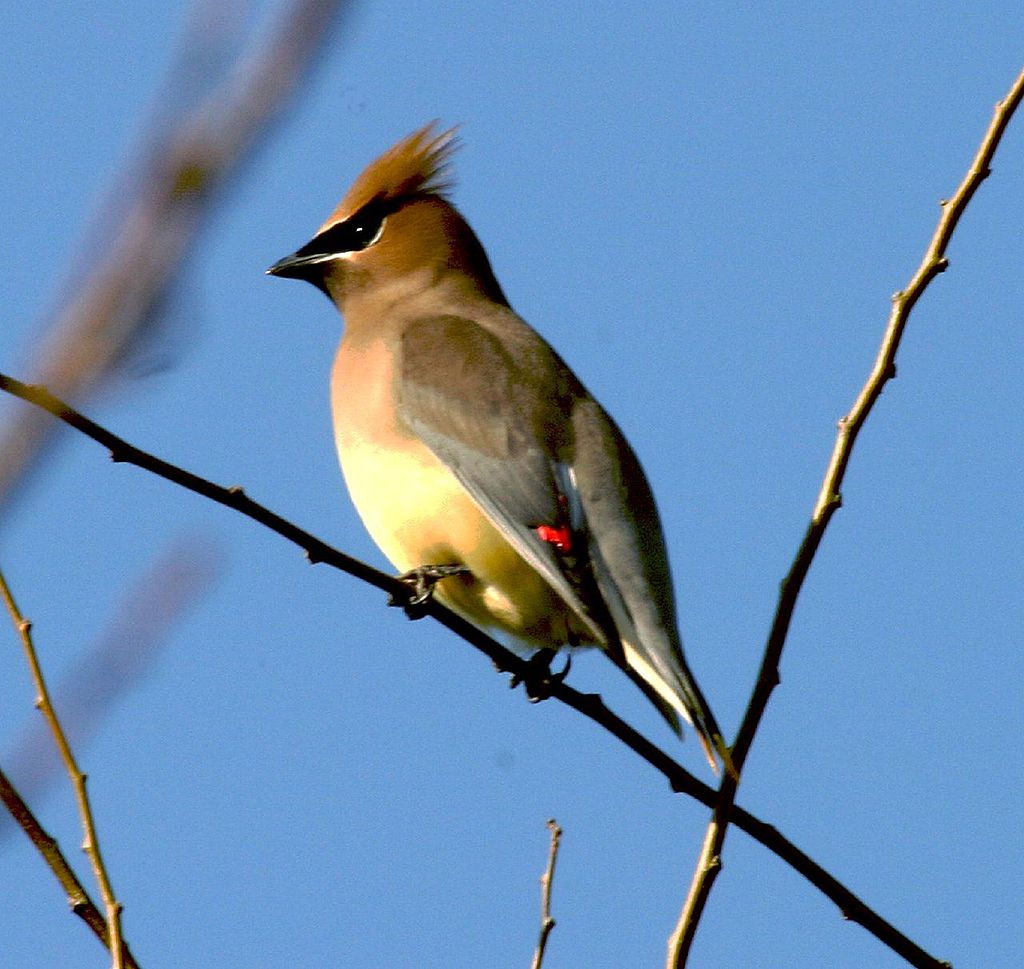
Coloration and Markings: Cedar Waxwings have a dark, grayish brown at the top of their backs while the rest is a smooth gray. They have medium length, broad wings which are brown at the shoulders and soft gray overall, with a pan-flute shaped red-waxy set of lines towards the center that can be tricky to spot and dark grey below at the inner edge of the wingtips. They have short, square tipped tails which are gray with yellow tips, with black just above the yellow and a white rump. The underbelly of this bird is a mix of base white and yellow while it becomes white and brown at the breast. Facially, these birds are a soft, brown color, with a lovely crest and a black mask that carries through the eyes and curls up to the crest’s termination at the back of the head. White underlines and over-lines this mask and this bird has a short, but thick triangular black or black and gray bill.
Size: These birds measure in at 5.5 – 6.7 inches in length and have wingspans of approximately 8.7 to 11.8 inches of width.
Habitat: These birds love just about any kind of woods and when they range out, they are frequent visitors to cultivated areas. Look for them around orchards, arboretums, parks, and lovely, well-kept backyards with a lot of plant life.
Diet: This bird eats a lot of flower petals and insects, so it might just make itself at home in your garden. Feeder-wise you can leave out some small berries of just about any kind and this bird will happily gobble them down.
Gray Catbird – Dumetella carolinensis

Coloration and Markings: Gray Catbirds tend to be a slate to blue-gray on their backs, their short wings, and their long, gray-to-black rounded tails. A foxy-brown patch is visible at the rump and the underbelly and breast of this bird are the same gray as the upper body. Facially, this bird has a gray or blue-gray face with a black cap and long, thin, straight black bill.
Size: These birds measure in at 8.3 – 9.4 inches in length and have wingspans of 8.7 to 11.8 inches wide.
Habitat: These birds love the forest’s edge, especially near water, and are frequently found wherever there is dense cover such as brush, brambles, thickets, thorns, and shrubs.
Diet: Peanuts, suet, and Black Oil Sunflower seeds are all favorites of the Gray Catbird.
Red-eyed Vireo – Vireo olivaceus
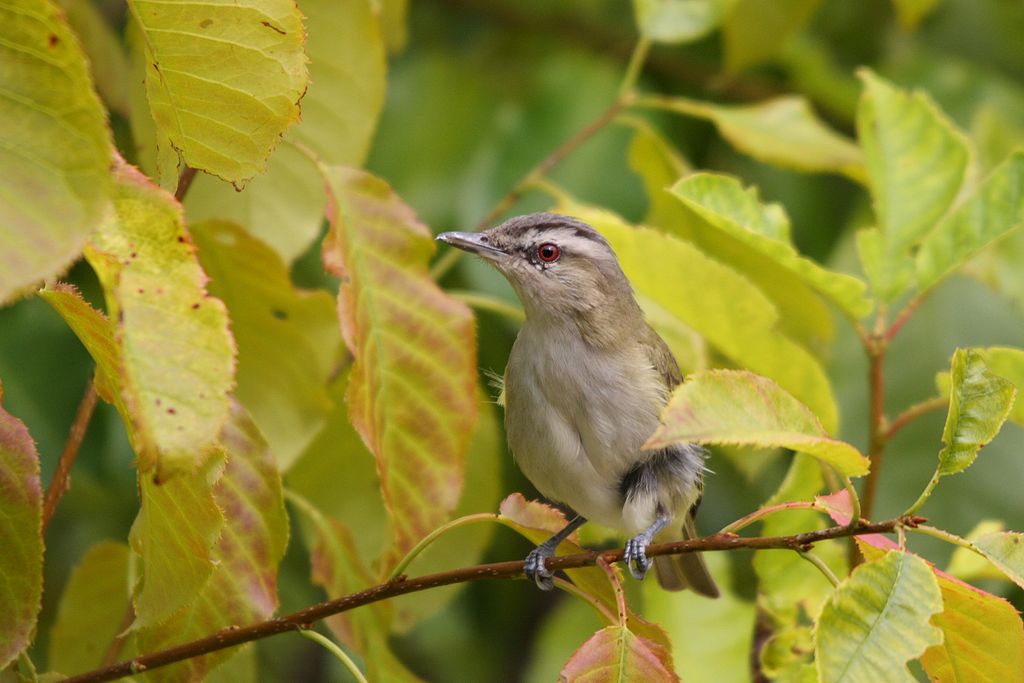
Coloration and Markings: Red-eyed vireos have olive green and yellow backs with medium-length wings and short, perky tails of the same color. The underbelly and breast of this bird are white and if you look closely you can see a greenish-yellow coloration is also present just underneath the wings. Facially, these birds have mostly olive colored faces, with a white chin, and some white above and below a thin, olive eyeline. This bird also has a silver crown and a black eyebrow line that makes the bird look a little angry. This bird has a medium-length black or black and white bill with a tiny, but noticeable hook at the tip of the bill. Note, only adult Vireos will have red eyes, while juveniles will simply have dark colored.
Size: These birds measure in at 4.7 – 5.1 inches in length and have wingspans of 9.1 to 9.8 inches wide.
Habitat: These birds love deciduous forests where they enjoy the cover of large leaves when they are perched on a comfortable branch. You can find them in just about any type of woods, however, and woodlots as well.
Diet: While primarily insectivorous, these birds do like small fruits and berries, so try a little sliced plum and cherries and you might just attract a Red-eyed Vireo.
American Robin – Turdus migratorius
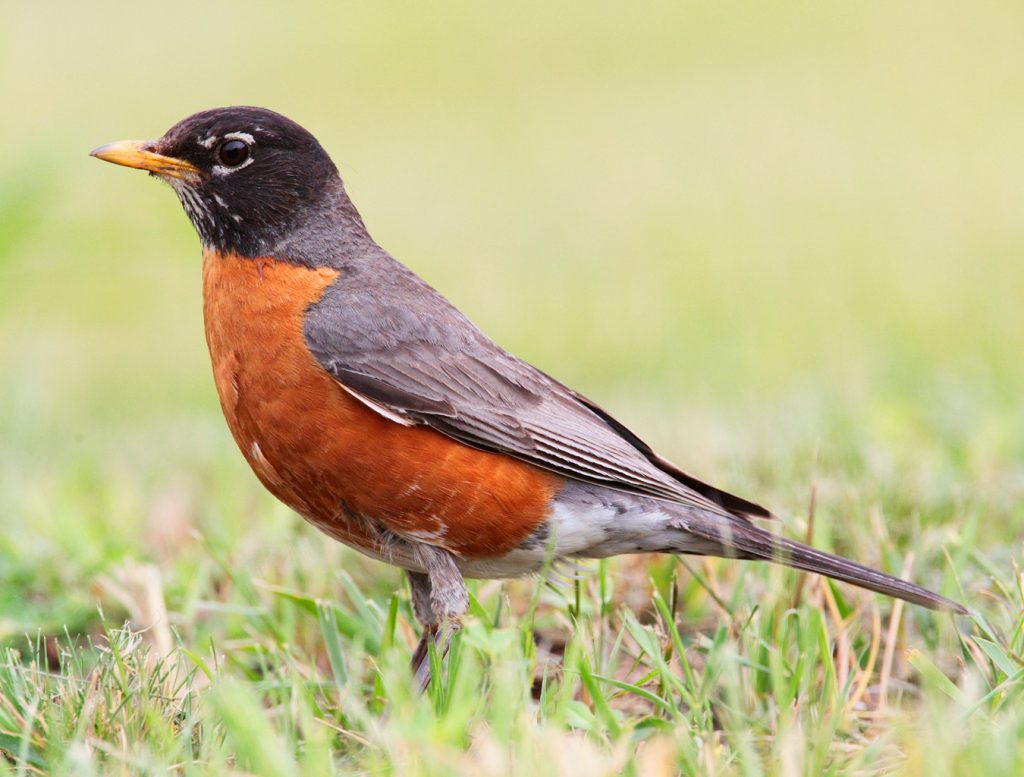
Coloration and Markings: American Robins have grayish-brown backs as well as medium-sized wings and long tails of the same color. They have white rumps but the underbelly and breast of this bird will be reddish-orange in color. Facially, these birds have black heads with eyerings, but the eyering-patterns encircling each eye will be ‘broken’. These birds have medium-length, yellow, and often black tipped bills with a slight but noticeable curve to them. Female Robins will have the same color patterns but with less contrasting of colors due to their muted nature.
Size: These birds measure in at 7.9 – 11 inches in length and have wingspans of 12.2 to 15.8 inches wide.
Habitat: When out in the wild these birds prefer deciduous woods, especially if there has been logging or the woods are recovering from a fire. They are also quite comfortable in residential areas, however, and you can even see them hopping around in the snow. They are well worth a closer look so be sure to show a little love in your feeder for the American Robin.
Diet: Robins eat a variety of things but feeder-favorites include suet, shelled peanuts, cracked corn, and any sweet fruits you might happen to have around.
Scarlet Tanager – Piranga olivacea
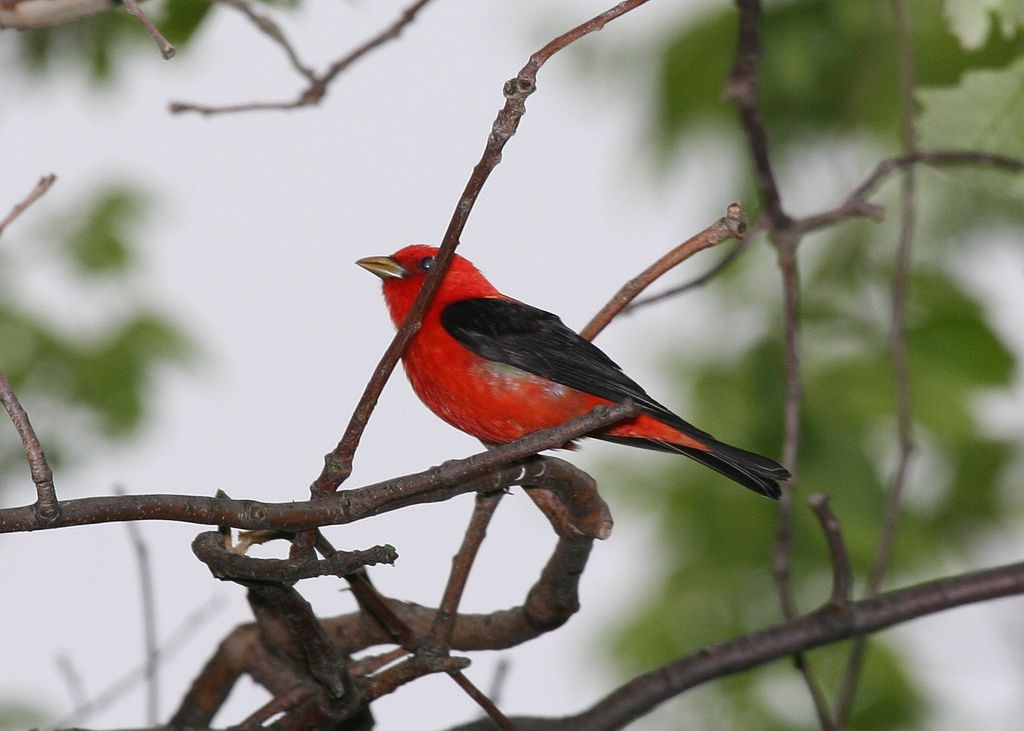
Coloration and Markings: Male Scarlet Tanagers are strikingly beautiful. They have rich red backs with medium-length black wings. These wings may be completely black or sometimes have a touch of yellow and red at the shoulders and faint traces of white may be seen above or below. They have short, but broad black tails and the underbelly and breast of the bird are rich red like the back. Facially, the red color deepens and these birds have large, thick, medium-length yellow bills. Females and juveniles will be an olive green and yellow with darker olive wings and after mating season the male will drop his red plumage for the same green and yellow while retaining the black wings.
Size: These birds measure in at 6.3 – 6.7 inches in length and have wingspans of 9.8 to 11.4 inches wide.
Habitat: These birds prefer woods of deciduous or mixed deciduous and evergreen varieties, though they will range out into other areas as long as there is some shrub cover in the form of bushes, brambles, thickets, and thorns. They do visit backyards so be sure to leave a little something out as these birds are quite a sight to see.
Diet: Suet, grape jelly, and orange slices are a tried and true favorite for getting the attention of Scarlet Tanagers.
New Hampshire’s Fall and Winter Birds
Winter lows in New Hampshire can fall down to -4 degrees Fahrenheit and while a lot of birds have hightailed out for warmer weather there are still a number of species who are quite happy to tough it out in exchange for the stunning scenery and abundant foraging. See if you can spot one these birds this winter:
- Purple Finch
- White-throated Sparrow
- Rose-breasted Grosbeak
- Song Sparrow
- Pine Siskin
Purple Finch – Haemorhous purpureus
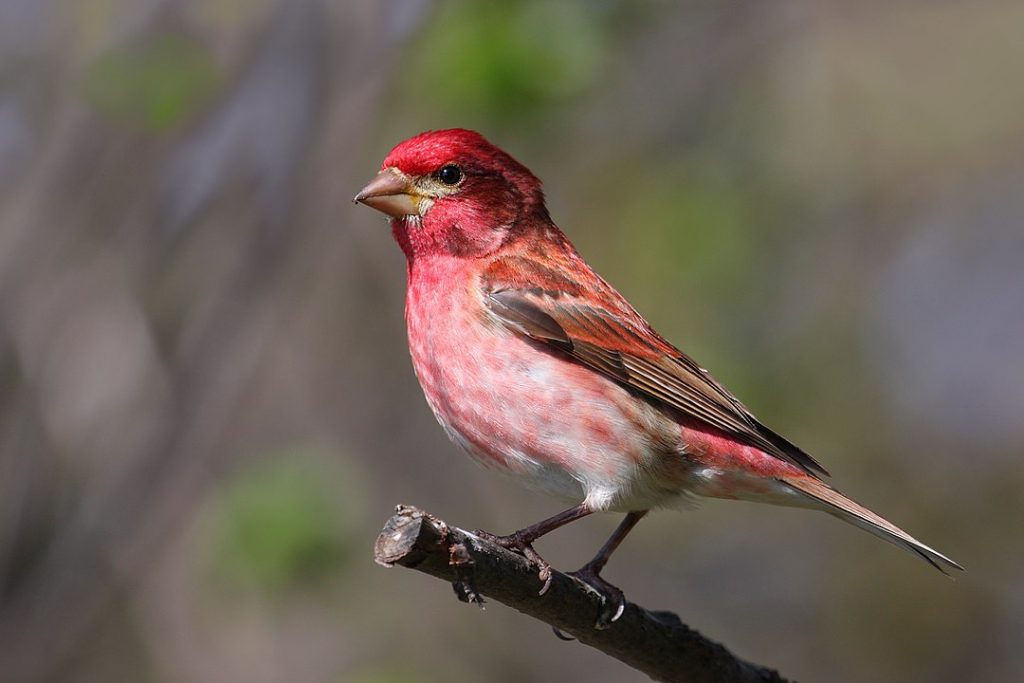
Coloration and Markings: Purple Finches have raspberry colored backs with long, banded-brown wings which have raspberry coloration mixed in as well as 2 thin white wingbars on each wing. They have short, notched tails and the underbelly of this bird is white with raspberry streaking. Further up at the breast you will see white with a heavy concentration of reddish-pink and facially, this bird is a combination of dark and light raspberry colors, with a dark eyeline which is wide and which curves around the cheek to terminate on the other side and a dark raspberry coloration which begins just behind the forehead at the top of the head and carries down to the nape of the neck. These birds have stocky, conical yellow and black bills. Females will be lacking the raspberry coloration, instead being olive colored with heavy streaking at the breast and underbelly, as well as a white eyebrow line and a white line coming down across the cheek.
Size: These birds measure only 4.7 – 6.3 inches from head to tail and have wingspans of 8.7 to 10.2 inches wide.
Habitat: When it is warmer, these Finches prefer coniferous woods but they also frequent coniferous and deciduous mixed woods. They range quite a bit in the winter, when you can find them in parks, fields, and backyards with well-stocked feeders.
Diet: You should feed these birds Safflower seeds. While they like other kinds,Purple Finches are very fond of Safflower and the squirrels tend to leave it alone!
White-throated Sparrow – Zonotrichia albicollis
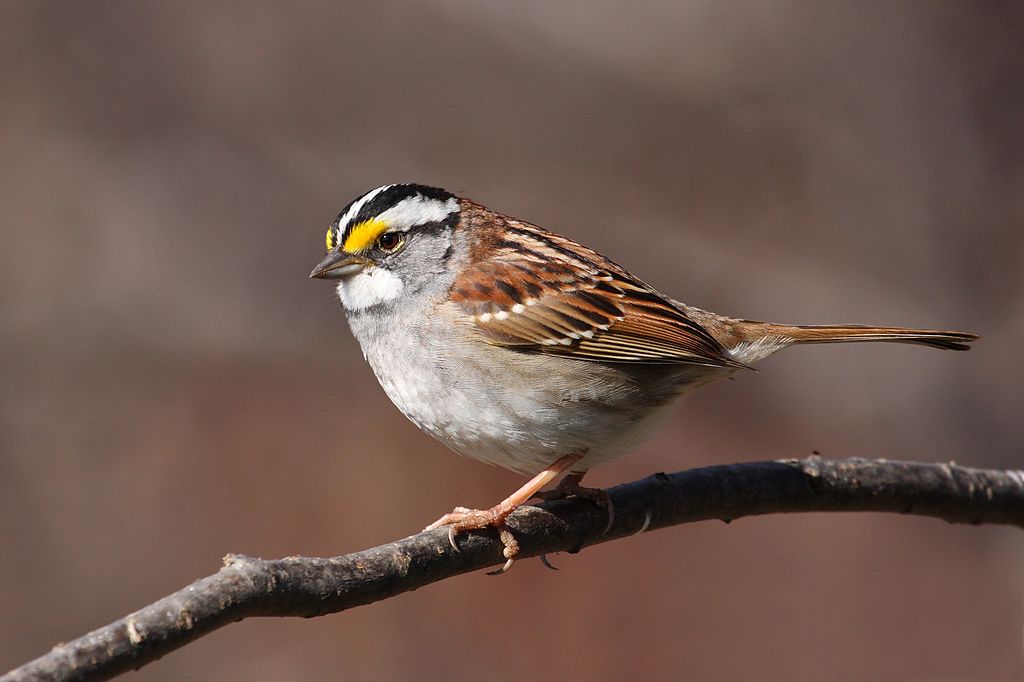
Coloration and Markings: White-throated Sparrows have brown backs with short, brown wings and long, brown tails. The wings exhibit 2 thin white wingbars on each wing if you look close and the underbelly and breast of this bird are white with a flanking of gray which starts at the underbelly and thickens as it moves up. Facially, these birds have gray faces with a white chin, a large, white eyebrow line, and a thin, black line starting from the back of the eye and going to the back of the head. The crown looks skunk-like, with black on the sides and a central white stripe. These birds have medium-length, conical silver bills. You can also see a variety known as ‘Tan striped’, which will have tan and brown instead of the black and white.
Size: These birds measure in at 6.3 – 7.1 inches in length and have wingspans of 7.9 to 9.1 inches wide.
Habitat: These birds love the forest’s edge, especially if there is water nearby in the form of a pond, river, or marsh. They range out often, especially in the winter, where you can find them at woodlots, parks, fields, and backyards.
Diet: White Proso millet and Black Oil Sunflower seeds are both favorites of this bird, just be sure to use a ground feeder and sprinkle a little around the base to help to get their attentions and tempt them to the feeder proper.
Rose-breasted Grosbeak – Pheucticus ludovicianus

Coloration and Markings: Rose-breasted Grosbeak males have black backs with medium-length black wings which sport a few white patches. They have long, black tails with some white present and with white on the undersides. The underbelly and breast of this bird are white with the occasional black line or three and at the breast is a large, inverted triangle of rose red that really gets your attention. Facially, this bird is black with a large, thick, and triangular yellow bill. Females and juveniles will be brown, rather than black, with a whitish eyestripe, and with an underbelly and breast that is heavily streaked and has a yellowish buff-tan coloration mixed with white. Both genders have color underneath their wings, with pink for males and yellow for females.
Size: These birds measure 7.1 – 8.3 inches in length and have wingspans of 11.4 to 13 inches wide.
Habitat: These birds like areas with coniferous and deciduous mixes but you will see them the most at the edge of the woods or in parks. They are also very, very fond of orchards, where they can exercise their sweet-tooth a little.
Diet: Suet, Black Oil Sunflower seeds, and fresh-chopped cherries are a great way to get the attentions of the Rose-breasted Grosbeak.
Song Sparrow – Melospiza melodia
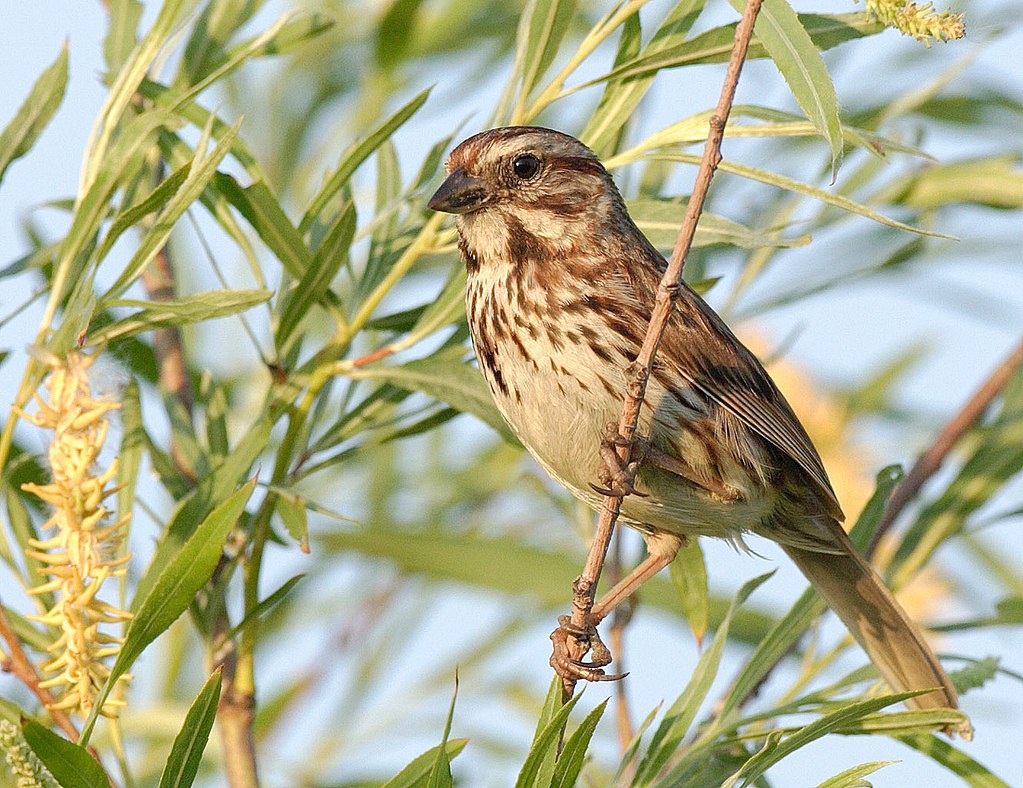
Coloration and Markings: Song Sparrows have gray and brown backs, with short, broad wings and long, perky tails, both of which are brown with tiny touches of gray. The underbelly and rbeast of this bird are white with heavy brown streaking and facially, this bird has a gray face with a brown eyeline, a white mustache mark with a brown stripe underneath, and a brown crown. These birds have short, but stocky conical gray bills.
Size: These little birds measure in at 4.7 – 6.7 inches in length and have wingspans of 7.1 to 9.4 inches in width.
Habitat: Song Sparrows thrive in a number of open environments, so you can spot them in desert areas, weedy fields, the forest’s edge, or playing in marshes or close to a stream. They are frequent feeder flyers so be sure to let them know that you are thinking of them through the expressive power of a full feeder.
Diet: Song Sparrows love White Proso millet and will happily much it from your feeder if you’ve been thoughtful enough to leave some out.
Pine Siskin – Spinus pinus
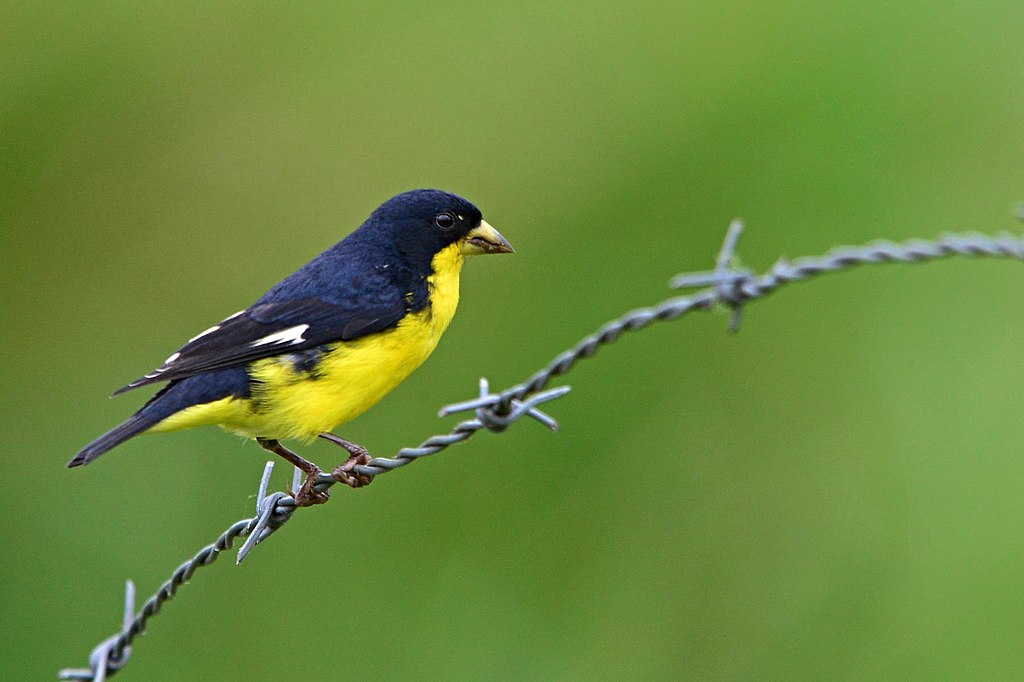
Coloration and Markings: Pine Siskins are extremely streaked birds. Their backs are mixes of tan and yellow with dark brown streaking, which you will also see on their medium-length wings and short, notched tails. Concentrations of bright yellow will often be present on both. The underbelly and breast of this bird are typically whitish with heavy brown streaking and facially, you will typically see tan with heavy, dark brown streaks as well as a short, stocky, and slightly curved brown-and-yellow bill.
Size: These diminutive birds measure in at 4.3 – 5.5 inches long and have wingspans 7.1 to 8.7 inches wide.
Habitat: These birds frequent deciduous woods or woods which are a mix of the evergreen and deciduous variety. They like to forage here and in any dense cover, so you can also watch for them in shrubs, thickets, and thorns where they can find seeds and load up on calories. They do visit backyard feeders so be sure to leave a little something out for them.
Diet: Nyjer thistle, White Proso millet, and hulled Black Oil Sunflower seeds provide a high energy meal that Pine Siskins will love.
Supporting cast (Other Backyard Birds of New Hampshire that might pay you a visit)
Just to hedge your bets, keep an eye out for our ‘Supporting cast’ birds. These birds can also be seen year round and they are quite lovely and willing to visit your feeder, provided that you’ve got it thoughtfully laid out to include a favorite or two. See if you can spot one of these Supporting cast birds at any time this year:
- Dark-eyed Junco
- Northern Cardinal
- Blue Jay
- White-breasted Nuthatch
- American Crow
Dark-eyed Junco – Junco hyemalis

Coloration and Markings: Dark-eyed Juncos have dark gray or brown as their base color for the upper 2/3 of their body. They have dark brown or gray backs, with medium-length wings and long, gray tails, which are white on the undersides. The underbelly and breast of this bird are white, but with a flanking of gray or dark brown which increases in mass as the coloration approaches and moves up the breast. Facially, these birds are dark gray or brown and have medium-length, stout, and conical pink bills.
Size: These birds measure in at 5.5 – 6.3 inches from tip to tail and have wingspans of 7.1 to 9.8 inches wide.
Habitat: These birds prefer coniferous and mixed-coniferous woods when it is warm. They do range out, however, especially in winter where they are common visitors at parks, fields, and backyards with well-stocked feeders.
Diet: These birds will eat Sunflower seeds but they really seem to prefer Red and White Proso millet.
Northern Cardinal – Cardinalis cardinalis
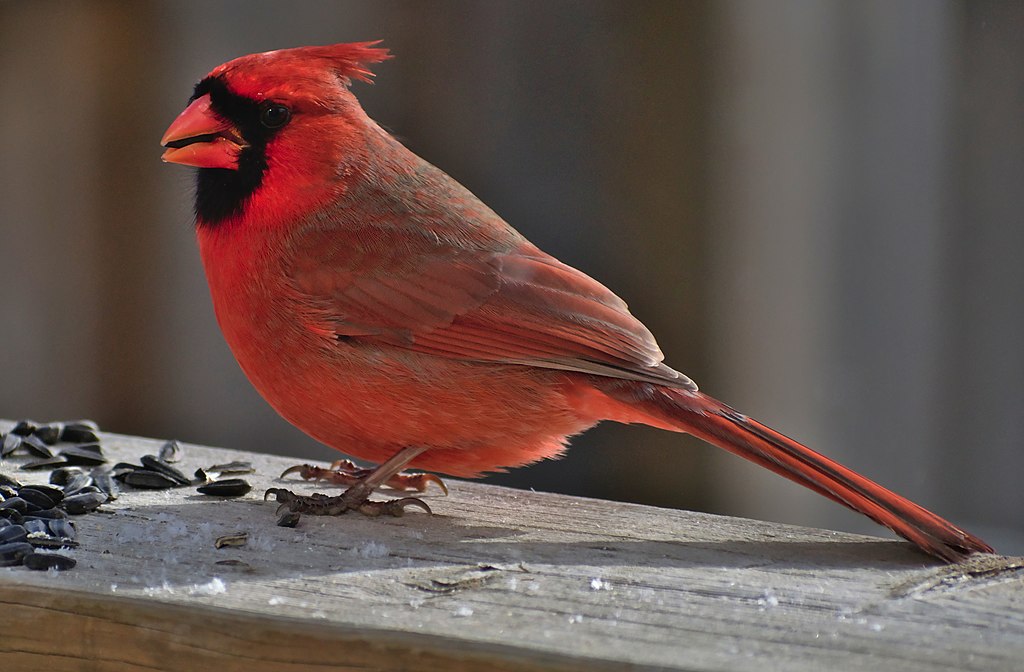
Coloration and Markings: Northern Cardinals have the kind of striking plumage that has inspired many a new birder. Being almost completely red, these birds have medium-length wings and long tails. Facially, you will notice the bird’s majestic red crest and signature mask, which covers the eyes but also pulls down into the chin where it looks like a little goatee. These bird have large but short conical orange to red-orange bills. Females will be a light brown color with some reddish tinges present but will still have a black mask.
Size: These birds measure in at 8.3 – 9.1 inches from head to tail and have wingspans of 9.8 to 12.2 inches.
Habitat: These birds like to live in inhabited areas, so look for them at forest edges that are close to human habitations as well as parks, orchards, or backyards. They do prefer areas where there is a bit of brush cover as well and you can occasionally spot them perched in bushes.
Diet: Raisins, cracked corn, and crushed peanuts are an easy combination that can attract and sometimes keep the attentions of the American Robin.
Blue Jay – Cyanocitta cristata
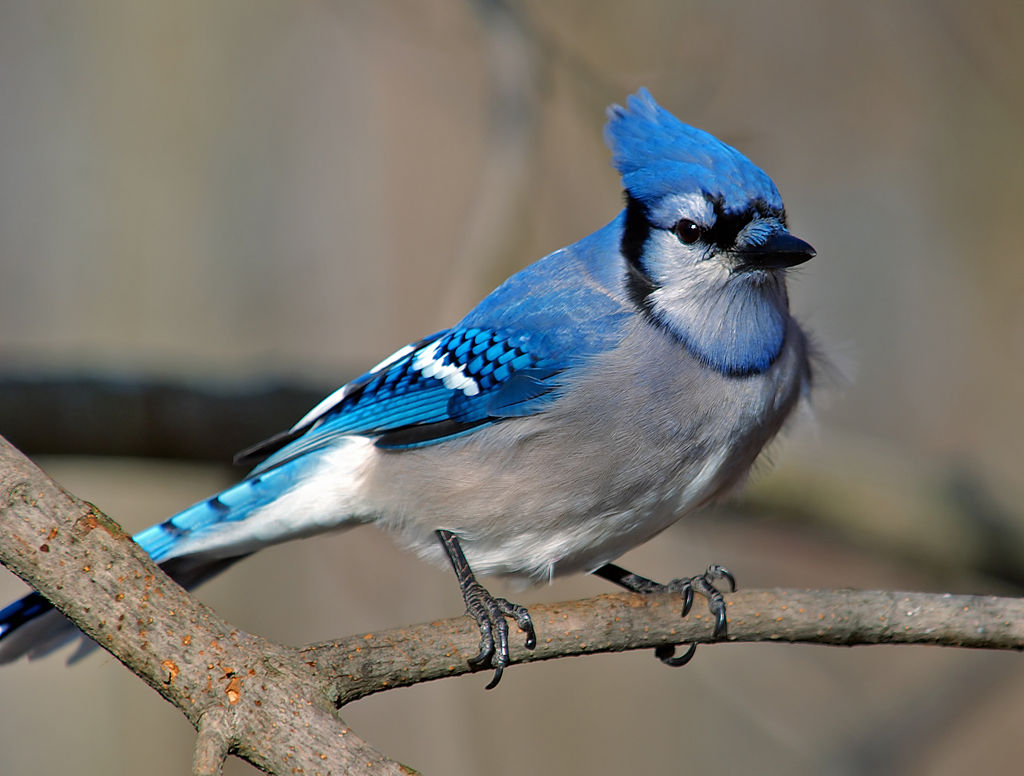
Coloration and Markings: Blue Jays are another prized sighting. Though fairly common, their plumage never fails to excite. These birds have deep blue backs with medium-length wings which display scaling patterns of black-outlined blue, as well as 1 white wingbar on each wing, and some large, white spots outlined in black as well towards the center of the wings. They have long, fanning tails which are blue with symmetrical patterns of light blue outlined in dark blue in squares going down the center length. White outer feathers are also present on these lovely tails. The underbelly and breast of this bird will be a brilliant white, and this white carried up into the face where it is interrupted briefly by a black line coming from the top of the head and encircling the throat. Facially, you will also notice the beautiful blue crest and a thin, somewhat abstract black mask that is distinctive to this bird. Finally, Blue Jays have long, straight black bills.
Size: These birds measure in at 9.8 – 11.8 inches in length and have wingspans of 13.4 – 16.9 inches.
Habitat: Blue Jays love the open woods, where they frequent meadows, clearings, and the forest’s edge. They are especially fond of Oak trees and their yummy acorns but they will also range out into parks and cities for foraging as well.
Diet: These birds love peanuts, suet, and cracked corn if you’ve got some handy. They also love birdbaths, in case you want to hedge your bets when it comes to luring a Blue Jay into your own backyard.
White-breasted Nuthatch – Sitta carolinensis

Coloration and Markings: White-breasted Nuthatches have bluish-gray backs, with medium lenth bluish-gray wings that display minor black edging and a very thin, hard to spot wingbar. They have short tails which are bluish gray with black outer feathers and which are white on the undersides. The underbelly and breast of this bird are white, with the exception of a warm, brown mark towards the underbelly and facially, this bird has a mostly white face with a few exceptions. These are a slanted black line rising up from the back of the eye, a long, black cap that carries down to the nape of the neck and towards the shoulders, and a long, thin bill that is often black on top and ivory colored below.
Size: These birds measure in at 5.1 – 5.5 inches in length and have wingspans of 7.9 to 10.6 inches wide.
Habitat: White-breasted Nuthatches may be found at the forest’s edge or inside old, matured forests. They have a fondness for deciduous stands but you can sometimes find them in coniferous woods as well.
Diet: Nuthatches love peanuts, suet, and Sunflower seeds of any kind. Put 1 or more of these out and you might just make a new best friend.
American Crow – Corvus brachyrhynchos

Coloration and Markings: American Crows are completely black, even their legs and feet! They have long, broad wings and short, but broad tails with squared tailfeathers. If you see a little brown on the Crow then this likely means that it is just molting into a new coat of feathers. Facially, these birds have a large, stout black bill with some slight curvature visible in the upper bill.
Size: These are good sized birds, measuring in at 15.8 – 20.9 inches in length with wingspans of 33.5 to 39.4 inches.
Habitat: Crows love open wooded areas and the forest’s edge, but they are quite often found in farms and cities as well. These clever birds are not afraid of people and they know that the foraging is good in inhabited areas, so you can see them just about anywhere that you can see people.
Diet: Peanuts, cracked corn, and Black Oil Sunflower seeds are all Crow favorites but you might want to just put them in an open areas, as these birds are sometime suspicious of feeders.
New Hampshire Bird Buffet
Creating a feeder that attracts the most diverse collection of birds is sort of the ‘Holy Grail’ of birding. To help in this, we’ve got a little advice from ourselves and from the Concord Monitor in their article “Time to break out the bird feeders”. Check out our references to view their full article if you would like to see what they have to say and in the meantime, consider adding 1 or more of these items to your feeders:
- Suet
- Nyjer thistle
- Black Oil Sunflower
- Grape jelly
- Crunchy peanut butter
New Hampshire Birding Hot Spots
The Chirparazzi know all the hot spots when it comes to catching a glimpse of your favorite stars. Today they’d like to share some great locations located in central New Hampshire as well as at the major compass points for those times when you feel like getting a little exercise and seeing your favorite feathered friends. Try visiting one of the following locations to scratch that birding itch:
- Northern hotspot – Upper Coos Recreational Trail
- Eastern hotspot – Farmington Recreational Rail-Trail
- Southern hotspot – Nashua River Rail Trail
- Western hotspot – Sugar River Trail
- Central hotspot – Goffstown Rail Trail
Detailed descriptions of each location as well as information regarding visiting and what birds you can see at these locations may be found at https://www.traillink.com/stateactivity/nh-birding-trails/
Some Final Words
Today we have taken a little journey into the world of birding in New Hampshire. As you can see, the scenery of this lovely state attracts a lovely assortment of birds to delight and impress. We hope that our tips will help you to see more local birds and set up that perfect backyard feeder arrangement that can add so much enchantment to your own backyard. Until next time, keep your binoculars close and your patience closer, because you never know when the next beautiful bird is going to make an appearance!
